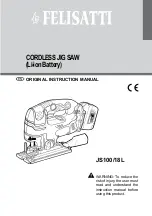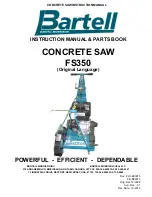
14
| English
Typically, the A-weighted sound pressure level of the power
tool is
70
dB(A). Uncertainty K =
5
dB. The noise level when
working can exceed 80 dB(A).
Wear hearing protection
Vibration total values a
h
(triax vector sum) and uncertainty K
determined according to
EN 62841-2-11
:
Cutting boards with saw blade
S 511 DF
:
a
h,B
=
6.0
m/s
2
, K =
1.5
m/s
2
,
Cutting wooden beams with saw blade
S 511 DF
:
a
h,WB
=
6.5
m/s
2
, K =
1.5
m/s
2
.
(The values relating to cutting boards with a saw blade are
valid for a thickness of 20 mm.)
The vibration level and noise emission value given in these
instructions have been measured in accordance with a
standardised measuring procedure and may be used to com-
pare power tools. They may also be used for a preliminary
estimation of vibration and noise emissions.
The stated vibration level and noise emission value repres-
ent the main applications of the power tool. However, if the
power tool is used for other applications, with different ap-
plication tools or is poorly maintained, the vibration level
and noise emission value may differ. This may significantly
increase the vibration and noise emissions over the total
working period.
To estimate vibration and noise emissions accurately, the
times when the tool is switched off or when it is running but
not actually being used should also be taken into account.
This may significantly reduce vibration and noise emissions
over the total working period.
Implement additional safety measures to protect the oper-
ator from the effects of vibration, such as servicing the
power tool and application tools, keeping their hands warm,
and organising workflows correctly.
Assembly
u
Remove the battery from the power tool before carry-
ing out work on the power tool (e.g. maintenance,
changing tool, etc.). The battery should also be re-
moved for transport and storage.
There is risk of injury
from unintentionally pressing the on/off switch.
Battery Charging (see figure A)
u
Use only the chargers listed in the technical data.
Only
these chargers are matched to the lithium-ion battery of
your power tool.
Note:
The battery is supplied partially charged. To ensure
full battery capacity, fully charge the battery in the charger
before using your power tool for the first time.
The lithium-ion battery can be charged at any time without
reducing its service life. Interrupting the charging process
does not damage the battery.
The lithium-ion battery is protected against deep discharge
by the "Electronic Cell Protection (ECP)". When the battery
is discharged, the power tool is switched off by means of a
protective circuit: The application tool no longer rotates.
u
Do not continue to press the On/Off switch after the
power tool has automatically switched off.
The battery
can be damaged.
To remove the battery
(4)
, press the release button
(5)
and
pull the battery downwards out of the power tool.
Do not
use force to do this.
Battery charge-control indicator
When the on/off switch
(7)
is pressed in halfway or com-
pletely, the battery charge indicator
(10)
indicates the bat-
tery's state of charge for several seconds. The indicator con-
sists of three green LEDs.
LED
Capacity
Continuous lighting 3 x green
≥2/3
Continuous lighting 2 x green
≥1/3
Continuous lighting 1 x green
<1/3
Flashing light 1 x green
Reserve
If no LED lights up after pressing the on/off switch
(7)
, then
the battery is defective and must be replaced.
Inserting/changing the saw blade
u
When fitting or changing the saw blade, wear protect-
ive gloves.
Blades are sharp and can become hot when
used for prolonged periods of time.
u
While replacing the saw blade, ensure that the saw
blade receptacle is free of material residue, e.g. wood
or metal chips.
Selecting the saw blade
You will find an overview of recommended saw blades at the
end of these operating instructions. Only use saw blades
with a 1/2" universal shank. The saw blade should not be
longer than required for the intended cut.
Inserting the saw blade (see figure B)
Turn the locking sleeve
(3)
approx. 90° in the direction of
the arrow and hold it firmly. Push the saw blade
(1)
into the
saw blade receptacle
(12)
. Release the locking sleeve again.
u
Check that it is seated securely by pulling the saw
blade.
A loose saw blade can fall out and lead to injuries.
For particular jobs, the saw blade
(1)
can also be flipped
180° (teeth point upwards) and refitted.
Removing the Saw Blade (see figure C)
u
Let the saw blade cool down before removing it.
There
is a risk of injury when touching the hot saw blade.
Turn the locking sleeve
(3)
approx. 90° in the direction of
the arrow and hold it firmly. Remove the saw blade
(1)
.
Dust/Chip Extraction
Dust from materials such as lead-containing coatings, some
wood types, minerals and metal can be harmful to one’s
health. Touching or breathing-in the dust can cause allergic
reactions and/or lead to respiratory infections of the user or
bystanders.
Certain dust, such as oak or beech dust, is considered carci-
nogenic, especially in connection with wood-treatment ad-
1 609 92A 4T8 | (26.03.2019)
Bosch Power Tools















































